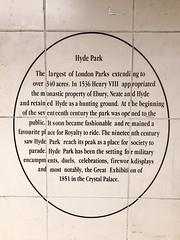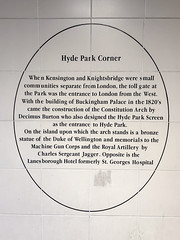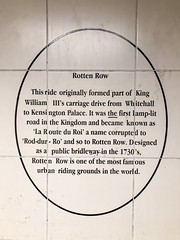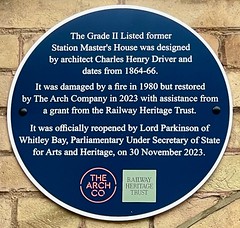Latest 20 plaques
Chinese Scholar Tree Japanese Pagoda Tree (Styphnolobium japonicum) (formerly Sophora japonica) This graceful tree is the largest and among the oldest of its kind known in Washington State. Its elegant form marks the northwest entrance of this historic Seattle Landmark park, originally designed by the Olmsted Brothers in 1904. Recognized as a Landmark Heritage Tree. Heritage Tree Program 03.1 Co-sponsored by PlantAmnesty and the City of Seattle April 2003
1635 11th Avenue, Seattle, United States
John Templeton 1765-1825 Naturalist, pioneer of Irish botany, Enlightenment thinker lived at Cranmore Malone
Tropical Ravine, Botanic Gardens, Belfast, United Kingdom
Subjects
Kennedy House 1965-1999 The site of John F Kennedy House, the Cathedral's Residential Youth Centre. Designed by Basil Spence, it was opened by Herr Willy Brandt, Mayor of West Berlin, to promote and encourage the Ministry of Reconciliation among the Young People of the World.
Top Hill, Coventry, United Kingdom
Subjects
Duncan Dallas (1940-2014) and Elizabeth Brice (1957-2011) [full inscription unknown]
: Regent Lodge, Regent Street, Chapel Allerton, Leeds, Yorkshire, United Kingdom
Subjects
Marie Randall MBE 1881-1965 First woman elected to the States Assembly lived here
1 St Julian’s Avenue, Guernsey, Guernsey
Subjects
Snug Park This oval is the site of a caravan village established to house forty six families rendered homeless by the fires of February 7th 1967. The village was closed on December 31st of that year.
Snug Sports Ground, Beach Rd, Snug, Australia
Joan Robinson 1903-1983 Economist lived here
44 Kensington Park Gardens, London, United Kingdom
Subjects
Peter Smith known as Poetry Peter was born in this house in 1874 Fisherman Poet of Cellardyke
14 George Street, Cellardyke, United Kingdom
Subjects
Hyde Park The largest of London Parks extending to over 340 acres. In 1536 Henry VIII appropriated the monastic property of Ebury, Neate and Hyde and retained Hyde as a hunting ground. At the beginning of the seventeenth century the park was opened to the public. It soon became fashionable and remained a favourite place for Royalty to ride. The nineteenth century saw Hyde Park reach its peak as a place for society to parade. Hyde Park has been the setting for military encampments, duels, celebrations, firework displays and most notably, the Great Exhibition of 1851 in the Crystal Palace.
Hyde Park Corner, London, United Kingdom
Subjects
Hyde Park Corner When Kensington and Knightsbridge were small communities separate from London, the toll gate at the Park was the entrance to London from the West. With the building of Buckingham Palace in the 1820's came the construction of the Constitution Arch by Decimus Burton who also designed the Hyde Park Screen as the entrance to Hyde Park. On the island upon which the arch stands is a bronze statue of the Duke of Wellington and memorials to the Machine Gun Corps and the Royal Artillery by Charles Sergeant Jagger. Opposite is the Lanes borough Hotel formerly St. Georges Hospital
Piccadilly, London, United Kingdom
Subjects
Rotten Row This ride originally formed part of King William Ill's carriage drive from Whitehall to Kensington Palace. It was the first lamp-lit road in the Kingdom and became known as 'La Route du Roi' a name corrupted to 'Rod-dur - Ro' and so to Rotten Row. Designed as a public bridleway in the 1730's, Rotten Row is one of the most famous urban riding grounds in the world
Piccadilly, London, United Kingdom
Subjects
Finta Márton (1791 - 1853) E tábla szolgáljon emlékül a geszterédi földbirtokosnak, az 1848-1849-es forradalom és szabadságharc Szabolcs vármegyei újoncozási polgári biztosának, a vármegyei honvédelmi bizottmány tagjának, a Kállóban működő szabolcsi katonai bíróság elnökének, akinek hatékony és önzetlen nemzetőr és honvéd sorozási szervező munkáját az osztrákok megtorolták, és 1851-ben halálra ítélték. A „kegyelemből” 6 évi várbörtönre változtatott ítéletét fájdalmakkal és betegségekkel küzdve előbb Olmützben, majd Josefstadtban töltötte. Két évnyi fogság után a nagy magyar hazafi élete itt ért véget. A halál megakadályozta, hogy a forradalom és a szabadságharc hőse viszontláthassa mindig vágyott és szeretett szülőföldjét. A geszterédi vértanú iránti tiszteletből állíttatta Geszteréd önkörmányzata. 2019 március 15.
English translation: Martin Finta (1791 - 1853) This plaque should serve as a memorial to the landowner of Geszteréd, the civil commissioner for the renewal of the revolution and the war of independence of 1848-1849 in Szabolcs County, a member of the county defense commission, the president of the military court in Szabolcs in Kallo, whose effective and selfless national guard and army guard sergeant his organizing work was retaliated by the Austrians and sentenced to death in 1851. He changed his sentence from “mercy” to six years in prison, struggling with pain and illness, and spent it first in Olmutz and then in Josefstadt. After two years of captivity, the life of the great Hungarian patriot ended here. Death prevented the hero of the revolution and the struggle for freedom from seeing again his always desired and beloved homeland. It was erected in honor of the martyr of Geszteréd in Geszteréd. March 15, 2019 [AWS Translate]
, Geszteréd, Hungary
This Oak Tree has been planted by North Hertfordshire District Council to commemorate the birth of His Royal Highness, Prince George of Cambridge on 22 July 2013
Howard Park and Gardens, Letchworth Garden City, United Kingdom
The Grade Il Listed former Station Master's House was designed by architect Charles Henry Driver and dates from 1864-66. It was damaged by a fire in 1980 but restored by The Arch Company in 2023 with assistance from a grant from the Railway Heritage Trust. It was officially reopened by Lord Parkinson of Whitley Bay, Parliamentary Under Secretary of State for Arts and Heritage, on 30 November 2023.
Windsor Walk, London, United Kingdom
Subjects
Aqui, conforme tradição oral, nasceu em 9 de janeiro de 1753 Luisa Rosa de Aguiar Todi, a maior cantora portuguesa e uma das figuras nacionais de projecção universal. Esta lápide foi mandada colocar no ano de 1953, segundo centenário do seu nascimento pela Câmara Municipal de Setúbal
English translation: Here, according to oral tradition, Luisa Rosa de Aguiar Todi, the greatest Portuguese singer and one of the national figures of universal projection, was born on January 9, 1753. This tombstone was ordered placed in the year 1953, the second centenary of its birth by the Setúbal City Council [AWS Translate]
Rua da Brasileira 51, Setúbal, Portugal
TÖRTÉNELMI EMLÉKHELY LUDOVIKA AKADÉMIA Az „1808. évi VII. törvénycikk a katonai Ludovika-akadémiáról” teremtette meg az önálló magyar tisztképzés lehetőségét. A Pollack Mihály tervei alapján 1830 és 1836 között elkészült klasszicista stílusú épület 1872-től szolgált a magyar honvédtisztképzés színteréül. 1945 után az épület otthont adott tisztképző, illetve felsőoktatási intézménynek, múzeumnak.
English translation: HISTORICAL MEMORIAL LUDOVIKA ACADEMY Article VII of the Military Law of 1808 Created by Ludovika Academy the possibility of independent Hungarian official training. Based on the plans of Mihály Pollack 1830 and a classicist completed between 1836 style building served from 1872 as the scene of Hungarian military officer training. After 1945, the building housed official training or higher education an institution, a museum. [AWS Translate]
, Budapest, Hungary
Vaults Two large vaults of brick construction, linked at the back, were built into the retaining wall on the north-western boundary of the canal basin in the middle of the 19th century. They were built for coal storage for the nearby gas works, when after 10 years the Coventry Canal Company won back the business from the railways.
Units 1-4 Coventry Canal Basin, Coventry, United Kingdom
Subjects
City Wall - adjoining Salvation Army Citadel. The City Wall was 2⅛ miles in circumference when it was completed in 1534, almost 200 years after building began. This section was finished in the early 15th century and archaeological excavations on this site in 1960 revealed traces of a semi-circular bastion and a defensive ditch. In 1662, the wall was destroyed by order of Charles II, and now only fragments remain
Lamb Street, Coventry, United Kingdom
Subjects
შენობა აგებულის 1911 წელს გერმანელი არქიტექტორის იოჰან დიცმანის პროექტის მიხედვეთ Dieses Gebäude wurde 1911 nach Entwürfen des einheimischen deutschen Architekten Johann Dizmann errichtet This building was built in 1911 in accordance with the design by the local German architect Johann Dizmann
English translation: The building was built in 1911 according to the project of the German architect Johann Dietzmann This building was built in 1911 after the Entwurfen des einheimischen deutschen Architects Johann Dizmann errichtet This building was built in 1911 in accordance with the design by the local German architect Johann Dizmann [AWS Translate]
11 Mikheil Zandukeli Street, Tbilisi, Georgia






.jpg?width=250)












